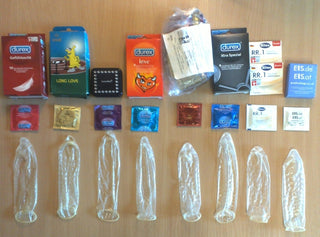Finding a condom that fits you right is nearly as difficult as finding a really great fitting pair of shoes. Sure you can measure your feet, but sometimes designers don’t list the width of a shoe, or your instep is higher or lower than expected, or they rub in the wrong spots, and some of us don’t have the resources to get a great fitting shoe. It’s the same with condoms.
Just like our bodies, condoms have different shapes and sizes. Finding one that really works on your body, well, that can be the difference between “Meh… condoms” and “Heck yeah! I’m gonna’ have sweet protected sex!”
We list a lot of measurements in our condom descriptions. What do they all mean and how do we use them? Read below for a description of the different measurements.
*All measurements are for un-stretched condoms*
Length: This is the length of the condom when completely unrolled, not including the reservoir tip. All condoms include a reservoir tip unless the description says otherwise.
Circumference: This is the distance around the base of the condom.
Diameter: This is the distance between the walls of the condom if the condom was filled in so that the end made a circle. Basically, it’s the distance between points that split a circle in two equal parts.
Nominal width: This is the length of the open end of a condom, from one side to the other, if the condom was laying flat. It’s the same as the circumference divided by two.
Thickness: This is how thick the wall of the condom is.
How do these measurements help you find a good fit? It would make sense to measure ourselves, and then find a condom that is about the same size, but sadly it’s not that simple. We need condoms to be tight, especially at the base of the penis so they stay on! But measuring your erect penis can help give you a place to start. To measure your penis you’ll want either some string and a ruler, or a flexible measuring tape (like the kind people use for sewing), and a calculator. The measuring tape can be used directly to find your measurements. The string can be used as something flexible that can go with the curves of your penis. You can make a mark where the measurement ends, lay the string flat and use the ruler to find the number of inches or centimeters.
Measuring your penis
Length: Put your measuring tool at the base of your erect penis closest to your stomach, not your balls, then measure to the tip. If you’re curved, follow the curve as you measure. The length of your penis can be used pretty directly to indicate what length condom you’ll want. A condom that’s too big can come off. One that’s too small can break. You always want the condom to be at least as long as your penis, never shorter. If it’s a bit longer, it can stay rolled up at the base.
Circumference: Use your measuring tool to measure the distance around the base of your erect penis. This measurement is important because the condom will only stay on if it’s tight enough down at the base. You want a condom that is snug there but not uncomfortable. We recommend a condom that has a circumference that’s a little smaller than yours. If a condom doesn’t list the circumference, you can use the measurements for diameter or nominal width to help find a good size.
Diameter: Measure your circumference as above. Take that number and divide it by 3.14. So, if you used a measuring tape and came up with 4.2” around the base of your penis, you take 4.2”/3.14. The answer is 1.34”, and that is the diameter of your penis. Your penis may be a different diameter further up but for condoms, you want to know what the diameter is at the base because that’s where the condom’s size dictates if it stays on or not. However, it is possible that a condom could be uncomfortable because of how tight it is around the tip. Sometimes condoms list a separate measurement for the tip.
Nominal width: Measure the circumference as you did above, then divide by 2. Same thing here, it’s the measurement at the base that’s important.
Now that you know how to measure your body, you can use it to make educated guesses about what size condoms will work best for you. We’d recommend you get a few condoms of different sizes and see which ones fit best. Then you can hone in on condoms around that size to see what you like most.
Remember, while getting a condom that is tight enough at the base is key for safety, if the condom moves more freely at the head of your penis, you’ll experience more sensation. Put just a drop of sexual lubricant in the tip of the condom before putting it on to help it move.
Also, you might want to try a condom while you masturbate. We know it sounds odd, but it lets you figure out sizing without any awkward moments of “this is too tight!” or “I think it just fell off.” And if you masturbate with a condom on, your body will get used to having orgasms that way. Once your body is used to coming with a condom on, you’ll be able to do it much more easily with a partner.
Happy measuring and safer sex to all!

